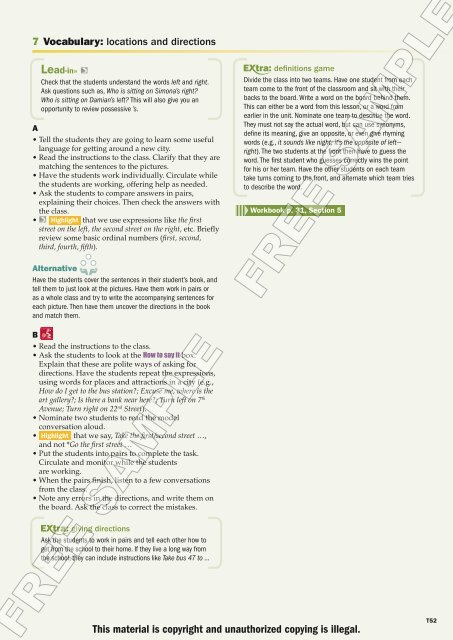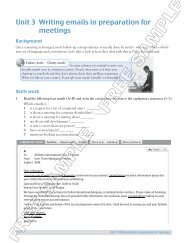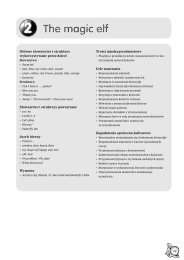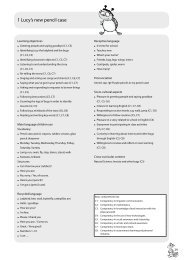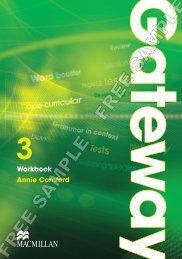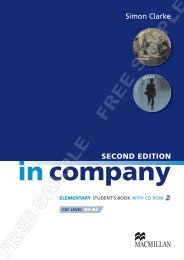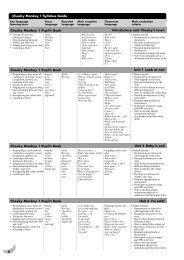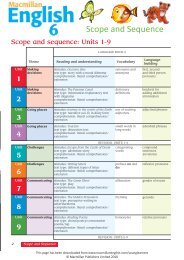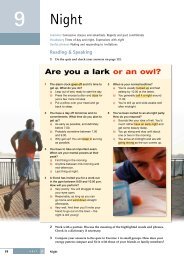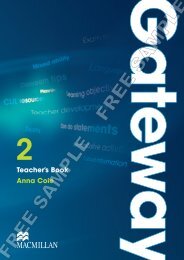there are - Macmillan
there are - Macmillan
there are - Macmillan
You also want an ePaper? Increase the reach of your titles
YUMPU automatically turns print PDFs into web optimized ePapers that Google loves.
7 Vocabulary: locations and directionsLead-in»Check that the students understand the words left and right.Ask questions such as, Who is sitting on Simona’s right?Who is sitting on Damian’s left? This will also give you anopportunity to review possessive ’s.A• Tell the students they <strong>are</strong> going to learn some usefullanguage for getting around a new city.• Read the instructions to the class. Clarify that they <strong>are</strong>matching the sentences to the pictures.• Have the students work individually. Circulate whilethe students <strong>are</strong> working, offering help as needed.• Ask the students to comp<strong>are</strong> answers in pairs,explaining their choices. Then check the answers withthe class.• Highlight that we use expressions like the firststreet on the left, the second street on the right, etc. Brieflyreview some basic ordinal numbers (first, second,third, fourth, fifth).AlternativeHave the students cover the sentences in their student’s book, andtell them to just look at the pictures. Have them work in pairs oras a whole class and try to write the accompanying sentences foreach picture. Then have them uncover the directions in the bookand match them.B• Read the instructions to the class.• Ask the students to look at the How to say it box.Explain that these <strong>are</strong> polite ways of asking fordirections. Have the students repeat the expressions,using words for places and attractions in a city (e.g.,How do I get to the bus station?; Excuse me, where is theart gallery?; Is <strong>there</strong> a bank near here?; Turn left on 7 thAvenue; Turn right on 22 nd Street).• Nominate two students to read the modelconversation aloud.• Highlight that we say, Take the first/second street …,and not *Go the first street …• Put the students into pairs to complete the task.Circulate and monitor while the students<strong>are</strong> working.• When the pairs finish, listen to a few conversationsfrom the class.• Note any errors in the directions, and write them onthe board. Ask the class to correct the mistakes.giving directionsAsk the students to work in pairs and tell each other how toget from the school to their home. If they live a long way fromthe school, they can include instructions like Take bus 47 to …definitions gameDivide the class into two teams. Have one student from eachteam come to the front of the classroom and sit with theirbacks to the board. Write a word on the board behind them.This can either be a word from this lesson, or a word fromearlier in the unit. Nominate one team to describe the word.They must not say the actual word, but can use synonyms,define its meaning, give an opposite, or even give rhymingwords (e.g., it sounds like night; it’s the opposite of left—right). The two students at the front then have to guess theword. The first student who guesses correctly wins the pointfor his or her team. Have the other students on each teamtake turns coming to the front, and alternate which team triesto describe the word.Workbook p. 31, Section 5FREE SAMPLE FREE SAMPLEThis material is copyright and unauthorized copying is illegal.T52


